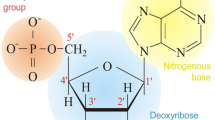Abstract
An attractive feature of DNA-based computers is the large number of possible sequences (4n) of a given length n with which to represent information. The problem, however, is that any given sequence is not necessarily independent of the other sequences, and thus, reactions among them can interfere with the reliability and efficiency of the computation. Independent sequences might be manufactured in the test tube using evolutionary methods. To this end, an in vitro selection has been developed that selects maximally mismatched DNA sequences. In order to understand the behavior of the protocol, a computer simulation of the protocol was done, results of which showed that Watson-Crick pairs of independent oligonucleotides were preferentially selected. In addition, to explore the computational capability of the selection protocol, a design is presented that generates the Fibonacci sequence of numbers.
Similar content being viewed by others
References
L. M. Adleman, “Molecular computation of solutions to combinatorial problems,” Science, vol. 266, pp. 1021-1024, 1994.
R. S. Braich, N. Chelyapov, C. Johnson, P. W. K. Rothemund, and L. Adleman, “Solution of a 20-Variable 3-SAT Problem on a DNA Computer,” Science, vol. 296, pp. 499-502, 2002.
A. Brennenman and A. E. Condon, “Strand Design for Bio-Molecular Computation,” http://www.cs.ubc.ca/condon/papers/wordsurvey.ps., 2001.
R. Deaton, J. Chen, H. Bi, M. Garzon, H. Rubin, and D. H. Wood, “A PCR-based protocol for in vitro selection of non-crosshybridizing oligonucleotides,” in Preliminary Proceedings of the Eighth Annual Meeting on DNA Based Computers, June 23–27, Sapporo, Japan, 2002, pp. 211-220.
R. Deaton, J. Chen, H. Bi, and J. A. Rose, “A software tool for generating non-crosshybridizing libraries of DNA oligonucleotides,” in Preliminary Proceedings of the Eighth Annual Meeting on DNA Based Computers, Sapporo, Japan, 2002, pp. 211-220.
R. Deaton, M. Garzon, J. A. Rose, D. R. Franceschetti, R. C. Murphy, and S. E. Stevens Jr., “Reliability and efficiency of a DNA based computation,” Phys. Rev. Lett., vol. 80, pp. 417-420, 1998.
R. Deaton, R. C. Murphy, M. Garzon, D. R. Franceschetti, and S. E. Stevens Jr, “Good encodings for DNA-based solutions to combinatorial problems,” in Preliminary Proceedings of the Second Annual Meeting on DNA Based Computers, Providence, RI, vol. 44, L. F. Landweber and E. B. Baum (eds.), DIMACS Workshop: Princeton, NJ, 1996, pp. 159-171.
A. G. Frutos, Q. Liu, A. J. Thiel, A. M. W. Sanner, A. E. Condon, L. M. Smith, and R. M. Corn, “Demonstration of a word design strategy for DNA computing on surfaces,” Nucleic Acids Research, vol. 25, p. 4748, 1997.
M. Garzon, R. Deaton, P. Neathery, R. C. Murphy, S. E. Stevens Jr., and D. R. Franceschetti, “A new metric for DNA computing,” in Genetic Programming 1997: Proceedings of the Second Annual Conference, July 13–16, Stanford University, 1997, pp. 479-490.
A. J. Hartemink and D. K. Gifford, “Thermodynamic simulation of deoxyoligonucleotide hybridization for DNA,” in Proceedings of the 3rd DIMACS Workshop on DNA Based Computers, H. H. Rubin and D. H. Wood (eds.), June 23–27, DIMACS Workshop: Philadelphia, PA, 1997, pp. 23-27.
R. J. Lipton, “DNA solution of hard computational problems,” Science, vol. 268, pp. 542-545, 1995.
J. A. Rose, R. J. Deaton, D. R. Franceschetti, M. Garzon, and S. E. Stevens Jr., “A Statistical Mechanical Treatment of Error in the Annealing Biostep of DNA Computation,” in Proceedings of the Genetic and Evolutionary Computation Conference, vol. 2, 1999, pp. 1829-1834. Orlando, FL.
G. Rozenberg and A. Salomaa, (eds.), The Mathematical Theory of L-Systems, Academic Press Inc.: New York, 1980.
J. SantaLucia Jr., “A unified view of polymer, dumbbell, and oligonucleotide DNA nearest-neighbor thermodynamics,” Proc. Natl. Acad. Sci., vol. 95, pp. 1460-1465, 1998.
Author information
Authors and Affiliations
Rights and permissions
About this article
Cite this article
Nuser, M., Deaton, R. Simulations of DNA Computing with In Vitro Selection. Genet Program Evolvable Mach 4, 173–183 (2003). https://doi.org/10.1023/A:1023937113468
Issue Date:
DOI: https://doi.org/10.1023/A:1023937113468




